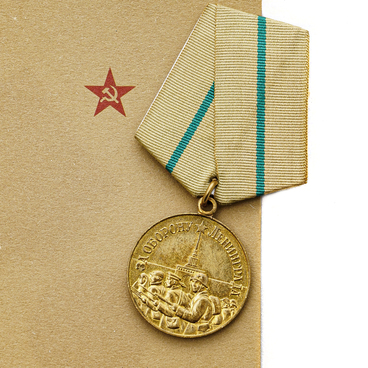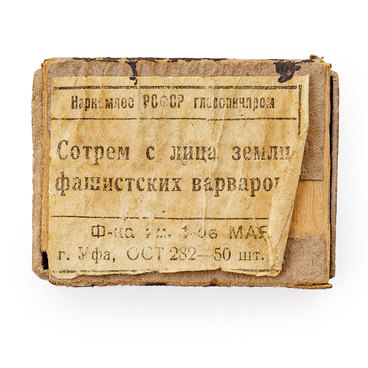Private epidemiology: for military physicians and epidemiologists/Under general editorship of Professor V.M.Berman, A.M.Levitov, I.I.Rogozin. 2nd edition, revised and enlarged. Leningrad: State Publishing House of Medical Literature, Leningrad division, 1941, 553 p.
From the very beginning of the Great Patriotic War all large hospitals in Ufa reorganized their work in accordance with the defence requirements. By order of the people’s commissar of health Andrei Fyodorovich Tretyakov, Bashkiria’s people’s commissariat of health under the leadership of people’s commissar Sabir Zakirovich Lukmanov began to set up evacuation hospitals.
In the summer of 1941 the All-Union Communist Party of Bashkortostan gave a command to set up a committee to provide for the sick and wounded soldiers and officers. This organization handled issues on all activities of evacuation hospitals: medical, administrative, party. It comprised over two hundred various collectives of Bashkiria.
Each hospital had a working patronage commission which was engaged in selecting junior medical staff, laundry of hospital linen, mending of clothing, care of patients, search for jobs for invalids, provision with food-stuffs, motor transport, fuel, construction materials etc.
On July 1, 1941 hospital No.1741 began working in clinic No.1. Its facilities were used by the 1st I.M.Sechenov Moscow Medical Institute transferred to the capital of Bashkiria. Wards were opened to treat heavily wounded, as well as traumatology, urology, ophthalmology and a number of others. Departments of the Bashkir Medical Institute where students and medical staff from other hospitals studied moved here.
The evacuation hospitals of Bashkiria belonged to the deep rear clinics, the heaviest cases were treated here. During three years personnel received 318 military trains with 163,350 wounded of which about 40% could not move without physical assistance. All in all, in the republic’s evacuation hospitals where 340 doctors and several thousand medical attendants worked 250 thousand patients were treated.
In the August of 1942 the Shafranovo health resort and the Yangan-Tau sanatorium joined the system of hospitals. During the work hundreds of treatment and rehabilitation methods were created and tested. Use of vitamins was substantiated for the first time, antireticular cytotoxic serum, boiling paraffin and other treatment methods, innovative at that time, were initiated.
Scientists of the USSR Academy of Sciences, USSR Academy of Medical Sciences, Moscow, Kiev, Minsk and Vitebsk Medical Institutes were working in the evacuation hospitals and other medical institutions of Bashkiria. Among them there were such luminaries as Pavel Evgenievich Lukomskiy, Alexei Alexandrovich Ostroumov, Nikolai Alexandrovich Semashko, Alexander Vkadimirovich Palladin, Boris Grigorievich Egorov. They brought up the entire generation of highly qualified doctors and scientists of the republic.
From the very beginning of the Great Patriotic War all large hospitals in Ufa reorganized their work in accordance with the defence requirements. By order of the people’s commissar of health Andrei Fyodorovich Tretyakov, Bashkiria’s people’s commissariat of health under the leadership of people’s commissar Sabir Zakirovich Lukmanov began to set up evacuation hospitals.
In the summer of 1941 the All-Union Communist Party of Bashkortostan gave a command to set up a committee to provide for the sick and wounded soldiers and officers. This organization handled issues on all activities of evacuation hospitals: medical, administrative, party. It comprised over two hundred various collectives of Bashkiria.
Each hospital had a working patronage commission which was engaged in selecting junior medical staff, laundry of hospital linen, mending of clothing, care of patients, search for jobs for invalids, provision with food-stuffs, motor transport, fuel, construction materials etc.
On July 1, 1941 hospital No.1741 began working in clinic No.1. Its facilities were used by the 1st I.M.Sechenov Moscow Medical Institute transferred to the capital of Bashkiria. Wards were opened to treat heavily wounded, as well as traumatology, urology, ophthalmology and a number of others. Departments of the Bashkir Medical Institute where students and medical staff from other hospitals studied moved here.
The evacuation hospitals of Bashkiria belonged to the deep rear clinics, the heaviest cases were treated here. During three years personnel received 318 military trains with 163,350 wounded of which about 40% could not move without physical assistance. All in all, in the republic’s evacuation hospitals where 340 doctors and several thousand medical attendants worked 250 thousand patients were treated.
In the August of 1942 the Shafranovo health resort and the Yangan-Tau sanatorium joined the system of hospitals. During the work hundreds of treatment and rehabilitation methods were created and tested. Use of vitamins was substantiated for the first time, antireticular cytotoxic serum, boiling paraffin and other treatment methods, innovative at that time, were initiated.
Scientists of the USSR Academy of Sciences, USSR Academy of Medical Sciences, Moscow, Kiev, Minsk and Vitebsk Medical Institutes were working in the evacuation hospitals and other medical institutions of Bashkiria. Among them there were such luminaries as Pavel Evgenievich Lukomskiy, Alexei Alexandrovich Ostroumov, Nikolai Alexandrovich Semashko, Alexander Vkadimirovich Palladin, Boris Grigorievich Egorov. They brought up the entire generation of highly qualified doctors and scientists of the republic.



